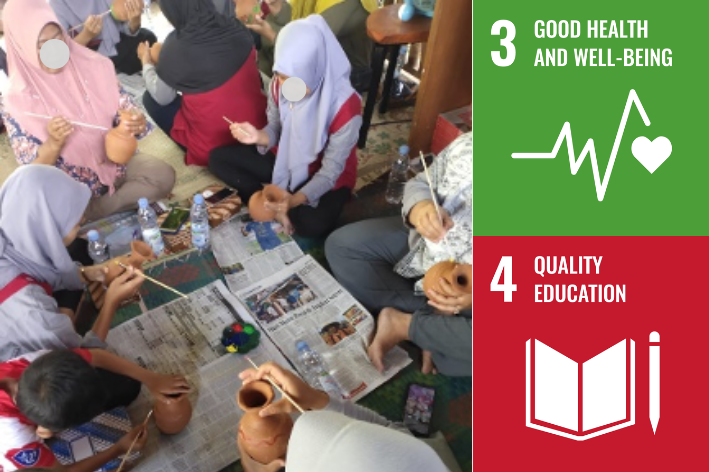Main Article Content
Abstract
Rapid technological advancements and societal changes significantly impact family life, particularly in child-rearing. Parents often face emotional challenges that can affect parenting styles and children's psychological development. This activity provided therapeutic art training to 18 homemakers in Jayan Village, Boyolali, to improve emotion regulation. Utilizing the Participatory Action Research (PAR) method, the training comprised three stages: planning, implementation, and evaluation. Results demonstrated increased parental awareness of emotion regulation and the effectiveness of therapeutic art in stress management. Through this activity, participants were able to channel both positive and negative feelings, thereby helping to prevent the accumulation of emotions that could have detrimental effects later on.
Keywords
Article Details

This work is licensed under a Creative Commons Attribution-NonCommercial 4.0 International License.
References
- Bosgraaf, L., Spreen, M., Pattiselanno, K., & van Hooren, S. (2024). Affect regulating art therapy for children and adolescents experiencing psychosocial problems. International Journal of Art Therapy: Inscape, 29(2), 88–96. https://doi.org/10.1080/17454832.2023.2208198
- Cahn, E. (2000). Proposal for a studio-based art therapy education. Art Therapy, 17(3), 177–182. https://doi.org/10.1080/07421656.2000.10129696
- Glew, S. G., Simonds, L. M., & Williams, E. I. (2021). The effects of group singing on the wellbeing and psychosocial outcomes of children and young people: a systematic integrative review. Arts and Health, 13(3), 240–262. https://doi.org/10.1080/17533015.2020.1802604
- Gross, J. J., & John, O. (2003). Individual Differences in Two Emotion Regulation Processes: Implications for Affect, Relationships, and Well-Being. Journal of Personality and Social Psychology, 85(2), 348–362. https://doi.org/10.1037/0022-3514.85.2.348
- Hajal, N. J., & Paley, B. (2020). Parental emotion and emotion regulation: A critical target of study for research and intervention to promote child emotion socialization. Developmental Psychology, 56(3), 403–417. https://doi.org/10.1037/dev0000864
- Hamidah, W., & Falah, A. M. (2023). Analisis Indikator Keberhasilan Proses Terapi Seni Sebagai Alternatif Metode Penyembuhan Kesehatan Mental. Jurnal ATRAT: Jurnal Seni Rupa, 11(2), 194–204.
- Hamzah, R., & Ghazanfer, M. (2023). Art Therapy as an Intervention for Stress Management in Patients with Anxiety Disorders: A Randomized Controlled Trial Analysis. Acta Psychology: Psychology and Health, 2(2), 49–57.
- Hidayat, D. R. (2018). Konseling di Sekolah (Pendekatan-Pendekatan Kontemporer). Kencana.
- Kimport, E. R., & Robbins, S. J. (2012). Efficacy of creative clay work for reducing negative mood: A randomized controlled trial. Art Therapy, 29(2), 74–79. https://doi.org/10.1080/07421656.2012.680048
- Kurniasih, U., Ali, M., Lestari, E. D., & Wahyuni, N. T. (2021). Pengaruh Art Therapy (Menggambar) Terhadap Stres Pada Lansia. Jurnal Kesehatan, 12(1), 26–32. https://doi.org/10.38165/jk.v12i1.234
- Lazarus, R. S., & Folkman, S. (1984). Stress, Appraisal, and Coping. Springer Publishing Company.
- Malchiodi, C. A. (2012). Art therapy and the brain. In Handbook of Art Therapy (2nd ed., pp. 17–26). The Guilford Press.
- Morris, A. S., Silk, J. S., Steinberg, L., Myers, S. S., & Robinson, L. R. (2007). The role of the family context in the development of emotion regulation. Social Development, 16(2), 361–388. https://doi.org/10.1111/j.1467-9507.2007.00389.x
- Muliawanti, L., Sandy, F., & Zahra, A. A. (2023). Empowerment and human resource capacity building in Homestay Village Borobudur, Magelang. Community Empowerment, 8(10), 1506–1511. https://doi.org/10.31603/ce.10195
- Nimphy, C. A., Kullberg, M. L. J., Pittner, K., Buisman, R., van den Berg, L., Alink, L., Bakermans-Kranenburg, M., Elzinga, B. M., & Tollenaar, M. (2024). The Role of Psychopathology and Emotion Regulation in the Intergenerational Transmission of Childhood Abuse: A Family Study. Child Maltreatment, 30(1), 82–94. https://doi.org/10.1177/10775595231223657
- Noviansah, W. (2024). Perkara Sepele Susu Tumpah Bikin Ibu Tiri Aniaya Anak hingga Luka-luka. In DetikNews.
- Rahyuni, F. (2024). Tak Hanya Cambuk, Ibu di Medan Juga Injak dan Pukuli Anaknya. In DetikNews.
- Rosyidi, M. I., Purwantini, A. H., Muliawanti, L., Purnomo, B. C., & Widyanto, A. (2021). Communication Participation in Community Empowerment for Energy Independent Tourism Villages in the Pandemic Era. E3S Web of Conferences, 232(79), 1–7. https://doi.org/10.1051/e3sconf/202123201036
- Rutherford, H. J. V, Wallace, N. S., Laurent, H. K., & Mayes, L. C. (2015). Emotion Regulation in Parenthood Helena. Physiology & Behavior, 1(36), 1–14. https://doi.org/10.1016/j.dr.2014.12.008
- Sari, S. K., Taufik, T., Prihartanti, N., & Japar, M. (2024). Peran hubungan orangtua-anak terhadap pembentukan regulasi emosi: Scoping review. Jurnal Psikologi Terapan Dan Pendidikan, 6(1), 78–93. https://doi.org/10.26555/jptp.v6i1.27847
- Strang, C. (2024). Art therapy and neuroscience: evidence, limits, and myths. Frontiers in Psychology, 15, 1–6. https://doi.org/10.3389/fpsyg.2024.1484481
- Subhan, M. (2024). Ayah di Pangkep Aniaya Balita hingga Lebam gegara Makan Biskuit di Kasur. In Detik.Com Sulsel.
- Susanti, D., Hantoro, D., Sandy, F., & Muliawanti, L. (2022). Social media for social movement: A social media training for Turun Tangan Organization. Community Empowerment, 7(8), 1429–1436. https://doi.org/10.31603/ce.7673
- Vinlandari, A., Syifauzakia, & Mulyana, A. (2022). Terapi Seni Sebagai Media Untuk Menjaga Kesehatan Mental Ibu Dalam Mendidik Anak Usia Dini. Proceedings of The 6th Annual Conference on Islamic Early Childhood Education, 6, 1–8.
- Wulandari, S., & Afiatin, T. (2020). Positive Parenting Program to Improve Mother Efficacy in Parenting Teenagers. Jurnal Psikologi, 47(1), 30. https://doi.org/10.22146/jpsi.44971
- Zitzmann, J., Rombold-George, L., Rosenbach, C., & Renneberg, B. (2024). Emotion Regulation, Parenting, and Psychopathology: A Systematic Review. Clinical Child and Family Psychology Review, 27(1), 1–22. https://doi.org/10.1007/s10567-023-00452-5

